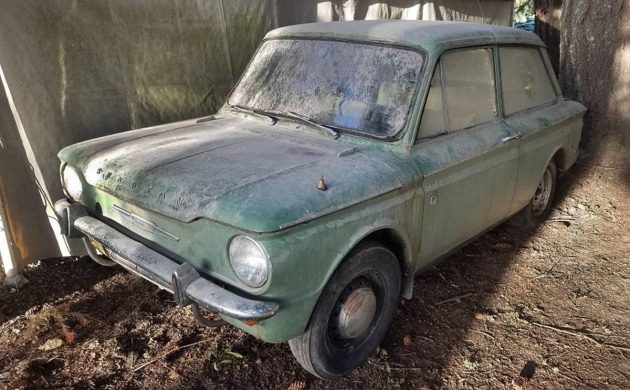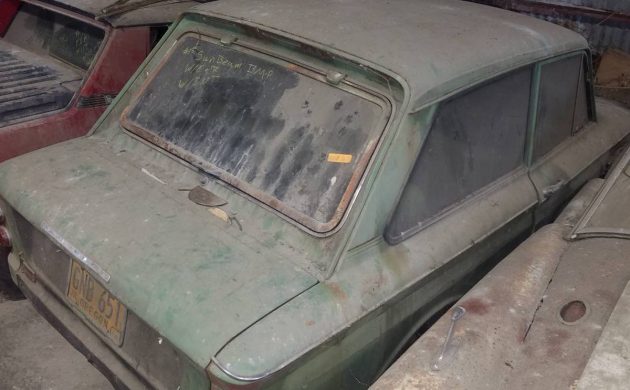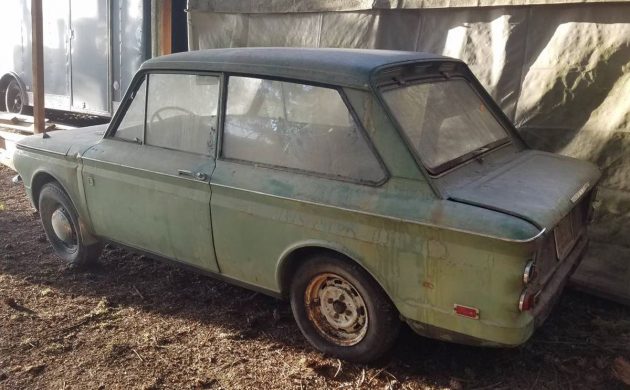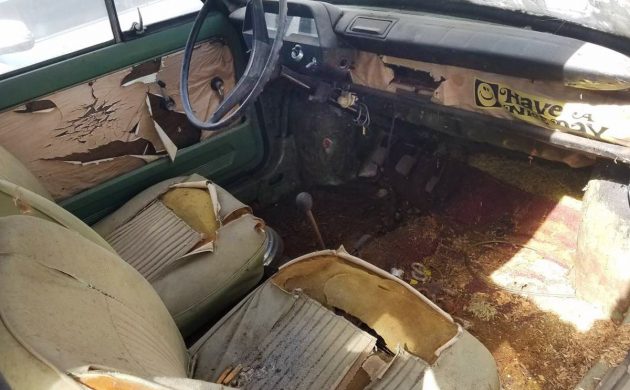Between a Mini and this 1963 Sunbeam Imp Mark I, there’s no question which one I’d want. This one, no really! I like my vehicles on the quirky side whenever possible and a rear-engine rear-drive car with the name Imp works just fine. The seller has this one posted here on craigslist in Aloha, Oregon and they’re asking a somewhat ambitious $3,495 for this Imp. Thanks to Matt H. for sending in this tip!
There are so many unusual and what I consider cool – if anyone under 100 uses that word anymore – features of these cars that I don’t know where to start. Just the general overall shape is enough to draw me in. The giant greenhouse with headroom for four adult passengers is unique and there’s the hinged rear window to provide access for additional storage behind the rear seat as seen in this photo. The trunk/boot is in the front since this is a rear-engine car.
There appears to be some damage to the left front fender and rust is a real issue on these cars. There is surface rust showing on the left rear wheel and I’m betting that there’s a fair share of it underneath as well. The Imp was made by what some folks refer to as Great Britain’s GM: The Rootes Group. A fun fact is that the Imp was reportedly the first mass-produced British car to have a rear-engine configuration.
There is a lot of work on the soft goodies inside that the next owner will have to attend to, but seats should be relatively easy to make look like new again. I’m not sure what’s going on with the dash but the padded portion on top looks almost perfect other than the edge. The floors look scary and they’re known for having issues with rusty floor pans. The back seat should have enough room for a couple of reasonably-sized adults to squeeze back there and ride for short distances. It looks almost perfect in the back other than the shag carpet.
The engine should be an 875 cc water-cooled four-cylinder which would have had around 50 horsepower. We don’t know anything about this car other than it’s been in storage for a long time and they say “lien paperwork for title”, but hopefully it can be saved. Have any of you had a Hillman or Sunbeam Imp?







Cool Sunbeam Imp and the first on of these I have seen. Using this as a rally car would the hinged rear glass be done away with? If not, I cannot buy into the Seller’s comment regarding “great rally car project” when the whole hinged back glass can become a flying projectile.
They were very good rally and race cars. Replace glass with plastic for competition use
Love Imps!! One of those someday cars!
You like the looks of the Imp but want much more. Try the early model Corvair 1960-1964.
I always thought the Imp was a blatant rip-off of the early model Corvair.
It’s nice to discover I’m not alone.
Half of Europe ripped off the Corvair. It was an incredibly influential design and everything from the Imp to the BMW 1602 copied from it
The Imp is liquid cooled. How exactly is it a rip off ?
Rare in the US They were available in other forms in GB. Mechanically similar to my Fiat 850 Coupe. 4 adults? You will be in slow lane.
Somehow, I remember the IMP having engines manufactured by Coventry Climax! Please correct me if i’m wrong.
Correct. They were assembled in the next door factory up un Linnwood (scotland). The real modrl to have us tge sunbesn stilleto….sport version with 4 headlights
Absolutely correct MarkO. I believe they were originally produced as an engine for pumping water and adapted by Rootes from a Coventry Climax FWMA fire pump engine which had enjoyed some success on the racing scene. The 600cc motor could supposedly do 90mph and it cornered like a painted stripe I believe.
A lien title means that the car is still owned by a creditor. Any loan that hasn’t been paid off on this car by now seems likely to represent a right to take possession.
The odds are it’ll take a lawyer to get to the bottom of the lien, so any buyer will be under water from the get go.
He’s got paperwork from a tow yard or a shop. That and a bill of sale you’ll be in and out of DMV with tags in an hour or less in Oregon.
Make mine a Sunbeam Stiletto!
https://www.heritagecarinsurance.co.uk/vital-stats/sunbeam-stiletto-1967-1973/
I don’t think it’s accurate that the Rootes Group was thought of as Great Britain’s GM, since that would have been Vauxhall, which was the British GM branch. Rootes Group would more accurately be the British arm of Chrysler, since they built badge engineered cars for sale in the US by Dodge and Plymouth, and we’re eventually bought out by Chrysler.
Excellent little cars. Engine was based on Coventry-Climax but re-engineered by Rootes. All aluminium and sohc was too sophisticated for Rootes dealers, so car got an early reputation for unreliability.
Engineers for Imp project were both racers, Tim Fry and Mike Parkes. Latter became Ferrari F1 driver. Imp was a very effective racer in sub 1000cc class, but outgunned by 1275 Mini Cooper S.
Growing up, my dad had some quirky little cars until the Japanese solidly hit the market. Including an English Ford estate 100 then parlayed to a Hillman Husky . I recall that one of the 2 had a wooden rear section behind the back seat that opened up to 2 jump seats making it an effective 6 to 7 seater depending on how uncomfortable the back seat passengers were. I’m looking for either for the sentimental value if anyone knows of any in the northeast US. Thanks.
Great D/sedan car in the day.Fun vintage racer today.
Thanks Martin Horrocks… for setting that straight- the engine has its design roots (sorry !) in the Coventry Climax OHC motor but was re-engineered and was always built in house by Rootes group.
The car had several flaws when launched that got it a very bad reputation for reliability from the start, including a novel but not-very-good pneumatic throttle. As is often the story, the car probably rushed to launch in a hurry to try and get some much-needed return on investment, leaving the customer to do the final stage of development testing. most of the bugs were eventually ironed out but by that time it was too late – the reputation once earned could not be shaken off. Sadly that was not a unique story for a lot of British-manufactured cars of the 60s and 70s.
They also suffered from poor build quality, partly because the Linwood factory in Scotland was brand new and starting with relatively untrained staff. The factory was deliberately sited in a location with economic problems, as a political attempt to relieve local unemployment. Similar thing to the Alfa Romeo “Alfasud” being manufactured in Southern Italy.
The production process was also pretty inefficient, as various components were produced back down in the English Midlands and parts and assemblies had to be shipped back and forward across the country.
Having said that, when I was a kid growing up in the UK in the 1970s – there were plenty of these around and they were seen as a slightly off-beat alternative to the much more ubiquitous Mini.
As noted by Scottymac, the Sunbeam Stiletto was a badged engineered version with fastback and uprated trim etc. There was even a prototype bodied by Zagato, called the “Zimp”…(google it – it’s kind of an interesting looking car)
There’s a good write up on the development history on “ARonline”
https://www.aronline.co.uk/cars/hillman/imp/
In Australia and probably England these were branded as a Hillman Imp the best one to get hold of was the Imp GT, used in racing quite successfully until the Mini came along.
A chap I know has several. One on the road, and one he’s fitting a Subaru engine & transaxle to. That should be ‘interesting’! They’re much easier to work on than you’d think- according to Murray.
Tony C. Yes, correct, the basic version was marketed as Hillman Imp in the UK with Sunbeam branding on the fancy Stiletto. Rootes group were pretty free and easy with the badge-engineering in the 1960s and 70s. Other models were sold in assorted Hillman, Sunbeam, Singer or Humber variations. A bit like GM, they had a pecking order of sort… Hillman was the base, Singer a bit more up-market trim, Sunbeam more likely to be sporty, and Humber the most luxurious trim level (I guess in line with the Humber company’s history of classy limousine type cars in the past)